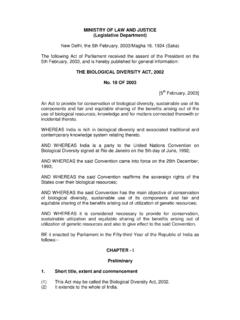Transcription of Biological Wastewater Treatment
1 IntroductionBiological Treatment is an important and integral part of any Wastewater Treatment plant that treats Wastewater from either municipality or industry having soluble organic impurities or a mix of the two types of Wastewater sources. The obvious economic advantage, both in terms of capital investment and operating costs, of Biological Treatment over other Treatment processes like chemical oxidation; thermal oxidation etc. has cemented its place in any integrated Wastewater Treatment plant. Biological Treatment using aerobic activated sludge process has been in practice for well over a century.
2 Increasing pressure to meet more stringent discharge standards or not being allowed to discharge treated effluent has led to implementation of a variety of advanced Biological Treatment processes in recent years. The title of this article being very general, it is not possible by any means to cover all the Biological Treatment processes. It is recommended that interested readers, for deeper reading and understanding, refer to well-known reference books Wastewater Engineering by Metcalf & Eddy etc. This article briefly discusses the differences between aerobic and anaerobic Biological Treatment processes and subsequently focuses on select aerobic Biological Treatment processes/technologies.
3 Biological Wastewater TreatmentThis article briefly discusses the differences between aerobic and anaerobic Biological Treatment processes and subsequently focuses on select aerobic Biological Treatment processes/technologies. By Arun Mittal Aerobic & Anaerobic Before we go in to the discussions of various aerobic Biological Treatment processes, it is important to briefly discuss the terms aerobic and anaerobic. Aerobic, as the title suggests, means in the presence of air (oxygen); while anaerobic means in the absence of air (oxygen). These two terms are directly related to the type of bacteria or microorganisms that are involved in the degradation of organic impurities in a given Wastewater and the operating conditions of the bioreactor.
4 Therefore, aerobic Treatment processes take place in the presence of air and utilize those microorganisms (also called aerobes), which use molecular/free oxygen to assimilate organic impurities convert them in to carbon dioxide, water and biomass. The anaerobic Treatment processes, on other hand take place in the absence of air (and thus molecular/free oxygen) by those microorganisms (also called anaerobes) which do not require air (molecular/free oxygen) to assimilate organic impurities. The final products of organic assimilation in anaerobic Treatment are methane and carbon dioxide gas and biomass.
5 The pictures in Fig. 1 and 2 depict simplified principles of the two processes. Table I summarizes the major differences in these two types of processes. From the summary in Table 1, it can be concluded 32 Water Today l August - 2011 Figure 1: Aerobic Treatment PrincipleFigure 2: Anaerobic Treatment Principlethat it is not anaerobic or aerobic Treatment , but a combination of the two types of the technologies that give an optimum configuration for those Wastewater Treatment applications where the organic impurities are at a relatively higher :Aerobic Biological Treatment TechnologiesThere are multitudes of aerobic Biological Treatment processes and technologies in literature and practice.
6 However, for the purpose of this article, following four Biological Treatment technologies are described. After description of each process and corresponding advantages/highlights, a qualitative comparison of these technologies is tabulated. This comparison is based on an actual Wastewater Treatment application for a refinery project, where the Treatment requirement was meant for discharge of treated effluent to the sea. A. Conventional Activated Sludge Process (ASP) System: This is the most common and oldest biotreatment process used to treat municipal and industrial Wastewater .
7 Typically Wastewater after primary Treatment suspended impurities removal is treated in an activated sludge process based Biological Treatment system comprising aeration tank followed by secondary clarifier. The aeration tank is a completely mixed or a plug flow (in some cases) bioreactor where specific concentration of biomass (measured as mixed liquor suspended solids (MLSS) or mixed liquor volatile suspended solids (MLVSS)) is maintained along with sufficient dissolved oxygen (DO) concentration (typically 2 mg/l) to effect biodegradation of soluble organic impurities measured as biochemical oxygen demand (BOD5) or chemical oxygen demand (COD).
8 The aeration tank is provided with fine bubble diffused aeration pipework at the bottom to transfer required oxygen to the biomass and also ensure completely mixed reactor. Roots type air blower is used to supply air to the diffuser pipework. In several older installations, mechanical surface aerators have been used to meet the aeration requirement. The aerated mixed liquor from the aeration tank overflows by gravity to the secondary clarifier unit to separate out the biomass and allow clarified, treated water to the downstream filtration system for finer removal of suspended solids.
9 The separated biomass is returned to the aeration tank by means of return activated sludge (RAS) pump. Excess biomass (produced during the biodegradation process) is wasted to the sludge handling and dewatering Cyclic Activated Sludge System (CASSTM): Cyclic Activated Sludge System (CASSTM) as the name suggests is one of the most popular sequencing batch reactor (SBR) processes employed to treat municipal Wastewater and Wastewater from a variety of industries including refineries and petrochemical plants. Aquatech has an agreement with AECOM (erstwhile Earth Tech), UK, the licensor of this technology to supply CASS technology in India on exclusive basis to both municipal and industrial markets.
10 This technology offers several operational and performance advantages over the conventional activated sludge process. The CASS SBR process performs all the functions of a conventional activated sludge plant ( Biological removal of pollutants, solids/liquid separation and treated effluent removal) by using a single variable volume basin in an alternating mode of operation, thereby dispensing with the need for final clarifiers and high return activated sludge pumping capacity. Water Today l August - 2011 33 The Cyclic Activated Sludge System (CASSTM), incorporates a high level of process sophistication in a configuration which is cost and space effective and offers a methodology that has operational simplicity, flexibility and reliability that is not available in conventionally configured activated sludge systems.









